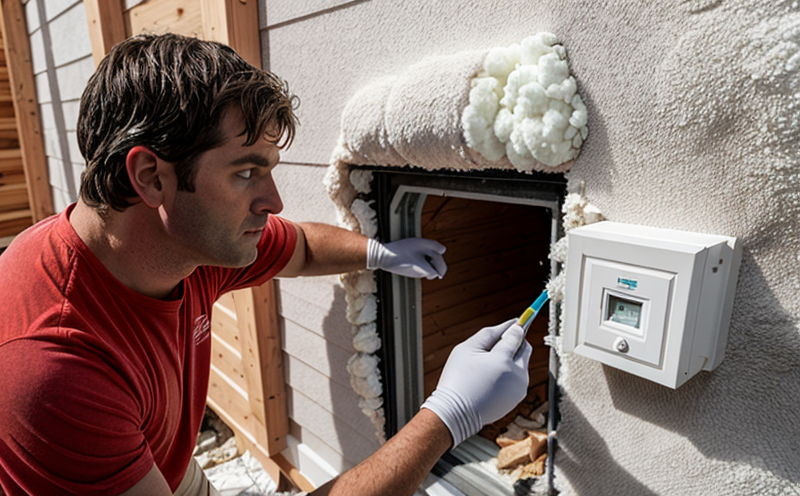EN 12667 Insulation Thermal Resistance Assessment
The European Standard EN 12667 provides a method for determining the thermal resistance of insulation materials and products. This standard is crucial in ensuring that building and infrastructure projects meet energy efficiency requirements set by various countries across Europe. By assessing the thermal performance, this test helps in selecting appropriate insulating materials that will contribute to reducing heat loss or gain, thus improving overall energy efficiency.
The process outlined in EN 12667 involves exposing a sample of insulation material under controlled conditions to steady-state heat flow and measuring the temperature difference across it. From these measurements, the thermal resistance (R-value) is calculated using specific formulas provided within the standard. Understanding this metric allows stakeholders like quality managers and R&D engineers to make informed decisions about the materials they specify for construction projects.
Accurate measurement of insulation performance according to EN 12667 ensures compliance with local building codes and standards, which often reference or incorporate these methods into their requirements. This not only enhances the sustainability credentials of new buildings but also contributes positively towards reducing carbon footprints associated with energy consumption in built environments.
For effective implementation of this standard during testing procedures, it is important to prepare specimens correctly according to ISO 9237 and ensure proper installation conditions mimic real-world scenarios as closely as possible. Rigorous adherence to both the specimen preparation guidelines and the testing environment helps achieve reliable results that can be trusted when making material selection decisions.
The outcome of EN 12667 tests plays a significant role in quality assurance processes for insulation products used in various sectors including residential housing, commercial buildings, industrial facilities, as well as public infrastructure projects. Compliance with this standard demonstrates commitment to best practices in sustainable design and construction techniques which are increasingly becoming essential factors considered by architects, engineers, and builders alike.
- Residential Housing: Ensuring optimal energy efficiency through proper insulation selection
- Commercial Buildings: Meeting strict regulations on thermal performance while maintaining cost-effectiveness
- Industrial Facilities: Achieving desired process temperatures within controlled environments
- Public Infrastructure Projects: Enhancing durability and longevity of structures against environmental elements
Industry Applications
The application of EN 12667 extends beyond just residential construction; it also finds relevance in numerous other industries where thermal insulation is paramount for energy efficiency and cost savings. In the healthcare sector, hospitals must maintain precise temperature control to preserve medication efficacy and patient comfort.
Education institutions benefit from improved learning environments with better controlled temperatures leading to increased productivity among students and staff alike. Hotels and resorts aim at creating luxurious yet economical spaces by optimizing heating and cooling systems based on accurate thermal resistance assessments.
In addition, the hospitality industry can leverage this standard effectively for enhancing guest satisfaction levels while simultaneously reducing operational costs through efficient energy management practices. Lastly, it is worth noting that EN 12667 has broader implications extending into renewable energy projects such as solar panel installations where proper thermal insulation ensures optimal performance.
By integrating the principles of EN 12667 into these diverse applications, organizations not only adhere to stringent regulatory requirements but also position themselves favorably within competitive markets by demonstrating their dedication towards sustainable development goals. This approach fosters innovation and continuous improvement across all facets of operations related to insulation materials.
Competitive Advantage and Market Impact
Adopting the EN 12667 standard provides significant competitive advantages in today’s market characterized by growing demand for energy-efficient solutions. Compliance with this international standard ensures that products meet stringent quality benchmarks set forth globally, thereby enhancing brand reputation among consumers who prioritize sustainability.
Moreover, adherence to such standards positions companies ahead of competitors who may not have invested adequately in developing robust testing methodologies or manufacturing processes aligned with these guidelines. This competitive edge translates into higher customer satisfaction levels resulting from superior product performance and reliability.
From an operational perspective, implementing EN 12667 allows for streamlined quality assurance procedures reducing time-to-market cycles and minimizing risks associated with non-compliance penalties imposed by regulatory bodies. In addition to these tangible benefits, adopting this standard fosters a culture of continuous improvement within organizations driving innovation towards more efficient use of resources.
The broader societal impact of adhering to EN 12667 cannot be overstated as it contributes significantly towards combating climate change through reduced greenhouse gas emissions. By promoting the use of energy-efficient materials, this standard supports global efforts aimed at achieving carbon neutrality by encouraging greater adoption of sustainable practices across various sectors.





